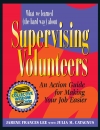Special Situations
1. Older Volunteers/Aging in Place
Older volunteers are a tremendous asset and potential talent pool. First, recognize that today’s "senior" needs to be approached by level of activity, not just date of birth:
-
Young seniors are often very active and fully capable of helping in any volunteer role. In fact, they can apply all sorts of formerly job-connected skills and devote lots of time to your organization. Female seniors in this age range may well have workplace credentials as well as homemaker talents.
-
Middle seniors may still be very competent, but may also have health, sight or hearing problems. They may limit their driving. They may also be resistant to things like electronic technology (though don’t assume this—many seniors love the Internet).
-
Older seniors are the fastest growing age category in our society. Everyone ages differently, but many of these volunteers may have limited physical capacity.
A related, but sometimes more problematic category, is the volunteer who is “aging in place.” This is someone who joined you when s/he was younger and fit, but has grown older and now has diminished capacity. The quandary, of course, is that you feel loyalty to a volunteer who has contributed many hours of devoted service and it is awkward to have to confront the changes in ability that age may bring. But for the sake of your service recipients and the volunteer personally, you must find ways to balance the best interests of everyone.
Supervision tips:
- Know the volunteer’s sight and hearing limits and give written material or oral instructions with this in mind.
- Pay attention to physical fatigue and talk with the volunteer about his/her strength and endurance.
- When possible, buddy them up with younger volunteers. This technique is especially good for volunteers “aging in place,” who know the job but could benefit from some support and perhaps oversight.
- Insist on a rotation policy for everyone so that no volunteer becomes so entrenched in one assignment that it’s impossible to make a change. Offer an “aging in place” volunteer an alternate assignment that makes use of long-time service, such as helping with new volunteer orientation—but only if s/he would be good at it!
- Don't ignore a deteriorating situation. Sometimes starting a concerned (but caring) conversation gives the volunteer the opening to admit to feeling insecure and less able to do the work s/he formerly considered a breeze.
- Only when appropriate, consider involving the volunteer's grown children in approaching their parent about changing abilities, or even the family physician.

